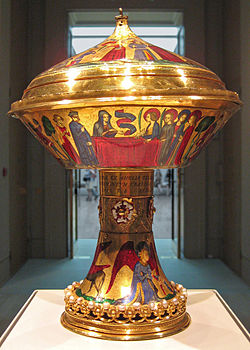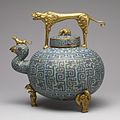Enamel (glass)

- For other uses of the word, see Enamel
Enamel is made of melted glass, often on metal. Sometimes called vitreous or porcelain enamel, it is made by fusing powdered glass to a base by firing, usually between 750 and 850 °C (1,380 and 1,560 °F). The powder melts, flows, and then hardens to a smooth, durable coating on metal, or on glass or ceramics.[1]
It has been used on decorative objects for two, or three thousand years, but especially in the Middle Ages in Europe. In the 19th century, it was used on everyday objects such as kitchen equipment and road signs. The glass is hard-wearing, scratch resistant and easy to clean.
Gallery
Silver, silver gilt and painted enamel beaker, Burgundian Netherlands, c. 1425–1450, The Cloisters, nyc
Limoges? grisaille painted Stations of the Cross, Notre-Dame-des-Champs, Avranches
St. Gregory the Great in painted Limoges enamel on a copper plaque, by Jacques I Laudin
Louis George enamel watch dial
Enamel (glass) Media
Chinese dish with scalloped rim, from the Ming dynasty; early 15th century; cloisonné enamel; height: 2.5 cm, diameter: 15.2 cm
Staffordshire Moorlands Pan, 2nd-century Roman Britain
Detail of painted Limoges enamel dish, mid-16th century, attributed to Jean de Court
Examples of art made of finift enamel from Kievan Rus
Chinese cloisonné enamel bronze wine pot, 18th century
Imperial vases by Ando Jubei, with the chrysanthemum crests of the Imperial family, using moriage to slightly raise the design; Khalili Collection of Japanese Art
Grey clouds, typical enamel cooking gear from the Dutch DRU factory, popular in the 1950s
References
- ↑
 Chisholm, Hugh, ed. (1911). . Encyclopædia Britannica (Eleventh ed.). Cambridge University Press.
Chisholm, Hugh, ed. (1911). . Encyclopædia Britannica (Eleventh ed.). Cambridge University Press. {{cite encyclopedia}}: Cite has empty unknown parameter:|coauthors=(help)















